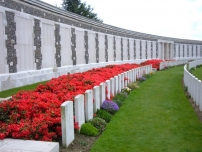| First Name: | William George | Last Name: | HUMPHREYS | |
|---|---|---|---|---|
| Date of Death: | 16/08/1917 | Lived/Born In: | Stroud Green | |
| Rank: | Private | Unit: | Lancashire Fusiliers9 | |
| Memorial Site: | Tyne Cot Memorial, Belgium | |||
Current Information:Enlisted-Stoke Newington
Third Battle of Ypres This was a campaign fought between July and November 1917 and is often referred to as the Battle of Passchendaele, a village to the north-east of Ypres which was finally captured in November. It was an attempt by the British to break out of the Ypres salient and capture the higher ground to the south and the east from which the enemy had been able to dominate the salient. It began well but two important factors weighed against them. First was the weather. The summer of 1917 turned out to be one of the the wettest on record and soon the battlefield was reduced to a morass of mud which made progress very difficult, if not impossible in places. The second was the defensive arrangements of concrete blockhouses and machine gun posts providing inter-locking fire that the Germans had constructed and which were extremely difficult and costly to counter. For 4 months this epic struggle continued by the end of which the salient had been greatly expanded in size but the vital break out had not been achieved. The Battle of Langemarck This took place between 16th-18th August, 1917 and was the second general attack of 3rd Ypres. Although it did not rain during the two days of the battle itself there had been plenty of it in the preceding days and in many places the battlefield was a quagmire. On the left of the attack in the north-west of the Ypres salient there was considerable success, especially for the French Army which attacked on the left of the British, but the attack on the Gheluvelt Plateau, due east of Ypres, met determined German resistance and the early gains were soon reversed. At 4.45am on 16th August, 1917, 11th Division attacked from out of the northern part of the Ypres salient, using the 5th Dorset and 8th Northumberland Fusiliers battalions of 34 Brigade for the initial assault after which the 11th Manchester and 9th Lancashire Fusiliers battalions continued the attack. On the right the 8th Northumberland Fusiliers were exposed to machine gun fire after the advance of the neighbouring 48th Division was checked and they were themselves held up at isolated posts and blockhouses and lost the protective artillery barrage. 5th Dorset on the left advanced steadily keeping in touch with 61 Brigade of 20th Division and reached the Langemarck road where they began consolidating. However they did not link up with 8th Northumberland Fusiliers so they formed a defensive flank on their right which stretched down to Haanebeek Farm. Following behind, the 9th Lancashire Fusiliers battalion made good progress until they came under fire from Bulow Farm on their right and another enemy strongpoint in front. They held for a while and then fell back to form a position with 11th Manchester. Nevertheless they continued to try to push forward and their left hand company moved from Rat House to Pheasant Trench and took the objective there and a platoon took the White House but then came under heavy shell fire. Being somewhat isolated and with enemy counter-attacks continuing, 5th Dorset later withdrew to a position 50 yards west of the White House. It was a day of mixed fortunes for 34 Brigade. In the face of strong opposition some objectives had been reached but by no means all of them and they had suffered many casualties. One of these was William Humphreys of 9th Lancashire Fusiliers. |
||||
| « Back to Search Results | ||||
| If you think any of the information shown here is incorrect, Click Here to submit your amends and comments | ||||




